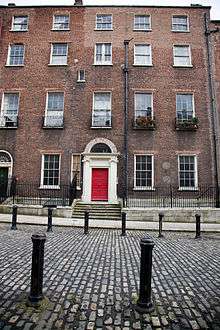Henrietta Street, Dublin
Coordinates: 53°21′09″N 6°16′12″W / 53.35250°N 6.27000°W
.jpg)


facing 9 and 10 Henrietta Street showing
Pearce's No. 11 on the left of the picture
Henrietta Street (Irish: Sráid Henrietta) is a Dublin street, to the north of Bolton Street on the north side of the city, first laid out and developed by Luke Gardiner during the 1720s.[1] A very wide street relative to streets in other 18th-century cities, it includes a number of very large red-brick city palaces of Georgian design.
Name
The street is generally held to be named after Henrietta, the wife of Charles FitzRoy, 2nd Duke of Grafton,[1][2] although an alternative candidate is Henrietta, the wife of Charles Paulet, 2nd Duke of Bolton. The nearby Bolton Street is named after Paulet.[3]
Georgian Dublin
Henrietta Street is the earliest Georgian Street in Dublin – it is the model from which Dublin’s Georgian identity is derived. Construction on the street started in the mid-1720s, on land bought by the Gardiner family in 1721. Construction was still taking place in the 1750s.[4] Gardiner had a mansion, designed by Richard Cassels, built for his own use around 1730.
The street was popularly referred to as Primate's Hill, as one of the houses was owned by the Archbishop of Armagh, although this house, along with two others, was demolished to make way for the Law Library of King's Inns.[1]
The street fell into disrepair during the 19th and 20th centuries, with the houses being used as tenements,[3] but has been the subject of restoration efforts in recent years.
There are currently 13 houses on the street. The street is a cul-de-sac, with the Law Library of King's Inns facing onto its western end.
It is also a popular period location for film and TV companies.[5] Among the productions filmed there are Albert Nobbs, Inspector George Gently and Foyle's War.
Economy
Some of these houses have suffered further deterioration following the slowing of the Irish economy in 2008. Most of these images are dated 2008-2010.
First residents
The street was popular with the great 18th-century families. The houses were built to have rear gardens and mews.[6]
North-side
No.3

This house, No.5, was divided about 1826 and the brown door provides access to the separate flat
- Builder
- Architect
- Resident Owen Wynne[6]
No.4
- Builder built after 1755[6]
- Architect
- Resident John Maxwell, 1st Baron Farnham from 1757, father-in-law of Owen Wynne at no.3. This house remained in the possession of the same family until 1852.[6]
No.5
- Builder Nathaniel Clements built about 1741 for Henry O'Brien[6]
- Architect
- Resident Henry O’Brien, 8th Earl of Thomond. Thomond died 2 years later and the house was occupied by George Stone, Bishop of Ferns, who later succeeded Boulter as Primate[6]
No.6
Separate flat within No. 5[6]
No.7
- Builder Nathaniel Clements about 1738[6]
- Architect
- Resident Nathaniel Clements[6]
No.8
No.9
- Builder Luke Gardiner by 1735[6]
- Architect Edward Lovett Pearce
- Resident Thomas Carter[6]
No.10
- Builder
- Architect Edward Lovett Pearce
- Resident Luke Gardiner[6]
Western end
Here is the entrance to King's Inns
South-side
Here is the King's Inns law library

No.s 12 (left) and 11
No.11
- Builder Luke Gardiner (built as a pair to No. 12)[6]
- Architect Edward Lovett Pearce[6]
- Resident Brigadier General William Graham[6]
No.12
- Builder Luke Gardiner (built as a pair to No. 11)[6]
- Architect Edward Lovett Pearce[6]
- Resident William Stewart, 3rd Viscount Mountjoy and later 1st Earl of Blessington[6]
No.13
- Builder Luke Gardiner 13, 14 and 15 simultaneously[6]
- Architect
- Resident Nicholas Loftus, 1st Earl of Ely from 1755 (1st record)[6]
No.14
- Builder Luke Gardiner 13, 14 and 15 simultaneously[6]
- Architect
- Resident Richard 3rd Viscount Molesworth from 1752[6]
No.15
- Builder Luke Gardiner 13, 14 and 15 simultaneously[6]
- Architect
- Resident Sir Robert King from about 1748[6]
See also
References
- 1 2 3 Craig, Maurice (2006) [1952]. Dublin 1660-1860. p. 129. ISBN 1-905483-11-2.
- ↑ "Henrietta Street, Dublin - Buildings of Ireland - Irish Architecture". Archiseek. Retrieved 2009-04-20.
- 1 2 "RSAI - Excursions and Outings - King's Inns and Henrietta Street". Royal Society of Antiquaries of Ireland. Retrieved 2009-04-20.
- ↑ Sheridan, Edel (2001). Brady, Joseph; Simms, Angrett, eds. Dublin Through Space & Time. Four Courts Press. pp. 91–93. ISBN 1-85182-641-6.
- ↑ Films
- 1 2 3 4 5 6 7 8 9 10 11 12 13 14 15 16 17 18 19 20 21 22 23 24 25 26 Shaffrey Associates Architects; John Montague, Architectural Historian; Carrig Conservation Ltd; Dr. Tracy Pickerill; Lee McCullough & Partners, Consulting Engineers; Boylan Farrelly, Quantity Surveyors; Henrietta Street Conservation Plan Dublin City Heritage
| Wikimedia Commons has media related to Henrietta Street, Dublin. |
External links
- Henrietta Street Conservation Plan published by the Dublin City Heritage Plan
- 7 Henrietta Street: a short history